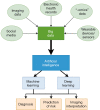Artificial intelligence in personalized cardiovascular medicine and cardiovascular imaging
- PMID: 34295713
- PMCID: PMC8261749
- DOI: 10.21037/cdt.2020.03.09
Artificial intelligence in personalized cardiovascular medicine and cardiovascular imaging
Abstract
The collection of large, heterogeneous electronic datasets and imaging from patients with cardiovascular disease (CVD) has lent itself to the use of sophisticated analysis using artificial intelligence (AI). AI techniques such as machine learning (ML) are able to identify relationships between data points by linking input to output variables using a combination of different functions, such as neural networks. In cardiovascular medicine, this is especially pertinent for classification, diagnosis, risk prediction and treatment guidance. Common cardiovascular data sources from patients include genomic data, cardiovascular imaging, wearable sensors and electronic health records (EHR). Leveraging AI in analysing such data points: (I) for clinicians: more accurate and streamlined image interpretation and diagnosis; (II) for health systems: improved workflow and reductions in medical errors; (III) for patients: promoting health with further education and promoting primary and secondary cardiovascular health prevention. This review addresses the need for AI in cardiovascular medicine by reviewing recent literature in different cardiovascular imaging modalities: electrocardiography, echocardiography, cardiac computed tomography, cardiac nuclear imaging, and cardiac magnetic resonance (CMR) imaging as well as the role of EHR. This review aims to conceptulise these studies in relation to their clinical applications, potential limitations and future opportunities and directions.
Keywords: Precision medicine; artificial intelligence (AI); cardiovascular imaging; deep learning (DL); machine learning (ML).
2021 Cardiovascular Diagnosis and Therapy. All rights reserved.
Conflict of interest statement
Conflicts of Interest: All authors have completed the ICMJE uniform disclosure form (available at http://dx.doi.org/10.21037/cdt.2020.03.09). The series “Heart Valve Disease” was commissioned by the editorial office without any funding or sponsorship. BX served as the unpaid Guest Editor of the series. The authors have no other conflicts of interest to declare.
Figures



References
-
- Mesko B. The role of artificial intelligence in precision medicine. Expert Rev Precis Med Drug Dev 2017;2:239-41. 10.1080/23808993.2017.1380516 - DOI
Publication types
LinkOut - more resources
Full Text Sources
